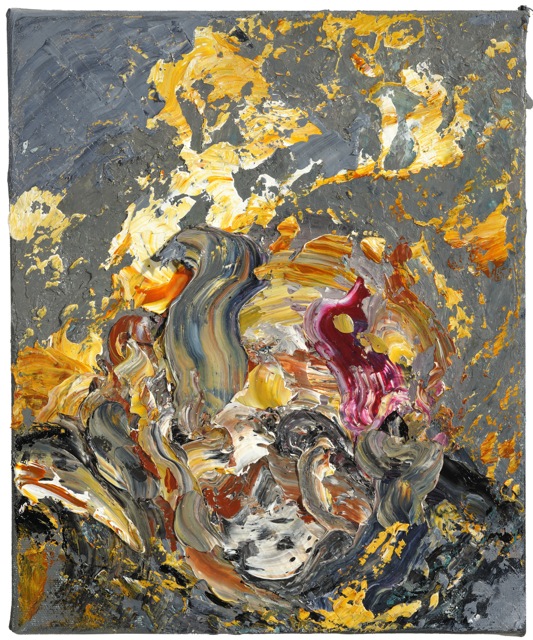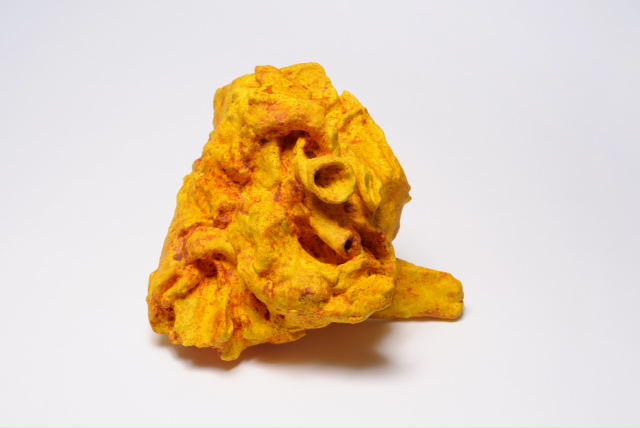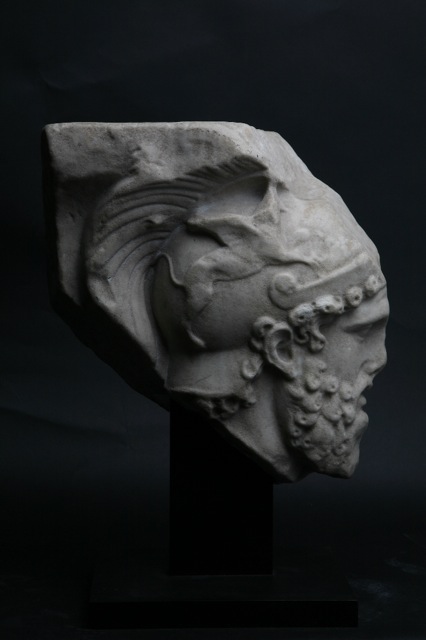Over the 12 days of Christmas, Apollo contributors and invited guests select their anticipated highlights of 2015
View the 12 Days series here

‘Victim XXX’ (2014), Maggi Hambling. © Maggi Hambling, Photo: Douglas Atfield
Following last year’s steady parade of centenaries and commemorations, Maggi Hambling’s exhibition ‘War Requiem & Aftermath’, opening on 4 March at the Cultural Institute, King’s College London, will grapple with war as a living and ceaseless reality (my book of the same title appears in conjunction with the show). The artist’s latest pictures of flickering war victims and flame-ridden battlescapes confirm her as one of Britain’s foremost contemporary painters – innovative and individualistic. Also included will be the new series of sculptures, Aftermath, in which Hambling has transformed gnarled pieces of wood into painted bronze totems, and a selection of earlier works confronting themes of war, death and memory – including the exquisitely ambivalent Gulf Women Prepare for War, of cloaked women bearing rocket launchers in a desert of blush pink.

‘Aftermath (Victim II)’, Maggi Hambling. © Maggi Hambling, Photo: Douglas Atfield
From 10 April, Camden Arts Centre will host an exhibition by another icon of contemporary painting, Jo Baer, whose ascetic beginnings as a Minimalist in the 1960s gave way in subsequent decades to a picaresque mode of figuration in which bodies, objects, symbols and landscapes are mapped out across a canvas, dreams seeming to take on diagrammatic form. At the centre of this show – a timely testament to Baer’s long career – will be a recent cycle of paintings based on a megalith in rural Ireland known as the Hurlstone.

Roman relief fragment depicting the head of Mars, 2nd century AD. Courtesy of Rupert Wace Ancient Art. On show as part of ‘CLASSICICITY’ at Breese Little gallery
The teeming mythosphere of Baer’s paintings, in which familiar and arcane spectres rub shoulders, offers an apt analogy for a show I will curate in March with fellow classicist Ruth Allen, ‘CLASSICICITY’, juxtaposing contemporary and ancient art. It opens on 5 March at Clerkenwell’s Breese Little gallery, which is fast garnering a reputation for scholarly and idiosyncratic projects. Organised in collaboration with Rupert Wace Ancient Art, ‘CLASSICITY‘ will re-represent classical art through the lens of contemporary responses (by artists including Edward Allington, Rachel Kneebone, Sarah Lucas and Alexandre Singh), inviting us to see antiquities not as museum artefacts but as seductive, emotive and provocative works of art in their own right.
‘Sculpture Victorious’ at Tate Britain will celebrate (no other word seems possible in light of the title) the sculpture and decorative plastic arts of the Victorian era. This long-in-the-planning project, devised by Martina Droth, Jason Edwards and Michael Hatt, comes to Tate from the Yale Center for British Art, and bears witness to an ongoing resurgence of interest in the art of the 19th century (evidenced also by Leighton House’s current display of Victorian paintings, which has been advertised on the back-end of virtually every bus in London, or Tate Britain’s 2012 Pre-Raphaelites blockbuster). ‘Sculpture Victorious’ promises to vanquish blanket notions of ‘the Victorians’ and their art (sentimental, chintzy, imperial, imperious) – veering from the high-camp designs of William Reynolds-Stephens to the brawny classical majesty of Lord Leighton’s An Athlete Wrestling with a Python.
View the rest of the 12 Days series here

12 Days: Highlights of 2015
'Aftermath (Victim II)', Maggi Hambling. © Maggi Hambling, Photo: Douglas Atfield
Share
Over the 12 days of Christmas, Apollo contributors and invited guests select their anticipated highlights of 2015
View the 12 Days series here
‘Victim XXX’ (2014), Maggi Hambling. © Maggi Hambling, Photo: Douglas Atfield
Following last year’s steady parade of centenaries and commemorations, Maggi Hambling’s exhibition ‘War Requiem & Aftermath’, opening on 4 March at the Cultural Institute, King’s College London, will grapple with war as a living and ceaseless reality (my book of the same title appears in conjunction with the show). The artist’s latest pictures of flickering war victims and flame-ridden battlescapes confirm her as one of Britain’s foremost contemporary painters – innovative and individualistic. Also included will be the new series of sculptures, Aftermath, in which Hambling has transformed gnarled pieces of wood into painted bronze totems, and a selection of earlier works confronting themes of war, death and memory – including the exquisitely ambivalent Gulf Women Prepare for War, of cloaked women bearing rocket launchers in a desert of blush pink.
‘Aftermath (Victim II)’, Maggi Hambling. © Maggi Hambling, Photo: Douglas Atfield
From 10 April, Camden Arts Centre will host an exhibition by another icon of contemporary painting, Jo Baer, whose ascetic beginnings as a Minimalist in the 1960s gave way in subsequent decades to a picaresque mode of figuration in which bodies, objects, symbols and landscapes are mapped out across a canvas, dreams seeming to take on diagrammatic form. At the centre of this show – a timely testament to Baer’s long career – will be a recent cycle of paintings based on a megalith in rural Ireland known as the Hurlstone.
Roman relief fragment depicting the head of Mars, 2nd century AD. Courtesy of Rupert Wace Ancient Art. On show as part of ‘CLASSICICITY’ at Breese Little gallery
The teeming mythosphere of Baer’s paintings, in which familiar and arcane spectres rub shoulders, offers an apt analogy for a show I will curate in March with fellow classicist Ruth Allen, ‘CLASSICICITY’, juxtaposing contemporary and ancient art. It opens on 5 March at Clerkenwell’s Breese Little gallery, which is fast garnering a reputation for scholarly and idiosyncratic projects. Organised in collaboration with Rupert Wace Ancient Art, ‘CLASSICITY‘ will re-represent classical art through the lens of contemporary responses (by artists including Edward Allington, Rachel Kneebone, Sarah Lucas and Alexandre Singh), inviting us to see antiquities not as museum artefacts but as seductive, emotive and provocative works of art in their own right.
‘Sculpture Victorious’ at Tate Britain will celebrate (no other word seems possible in light of the title) the sculpture and decorative plastic arts of the Victorian era. This long-in-the-planning project, devised by Martina Droth, Jason Edwards and Michael Hatt, comes to Tate from the Yale Center for British Art, and bears witness to an ongoing resurgence of interest in the art of the 19th century (evidenced also by Leighton House’s current display of Victorian paintings, which has been advertised on the back-end of virtually every bus in London, or Tate Britain’s 2012 Pre-Raphaelites blockbuster). ‘Sculpture Victorious’ promises to vanquish blanket notions of ‘the Victorians’ and their art (sentimental, chintzy, imperial, imperious) – veering from the high-camp designs of William Reynolds-Stephens to the brawny classical majesty of Lord Leighton’s An Athlete Wrestling with a Python.
View the rest of the 12 Days series here
Unlimited access from just $16 every 3 months
Subscribe to get unlimited and exclusive access to the top art stories, interviews and exhibition reviews.
Share
Recommended for you
Cézanne goes digital: catalogue raisonné launches online
As data increasingly migrates to the cloud, so art scholarship goes digital
12 Days: Highlights of 2015
An exceptional selection of exhibitions are opening in London this year, and some major museum openings are taking place further afield
Affordable Art
A new 50p piece, designed by Tom Phillips to celebrate the centenary of Benjamin Britten’s birth, attempts to ‘set the wild echoes flying’